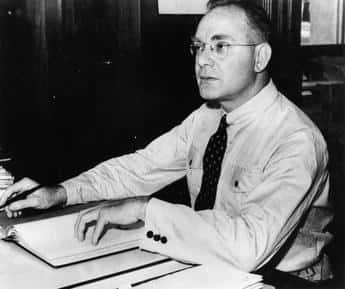
Name: Ray Cilento (Annerley)
Epoch: Early 20th Century (the \'Long Early Twentieth Century\')
Grouping Field: Health
Location Grouping: Individual\'s Work Location
Map Coordinates: 27°31\'05.9\"S 153°01\'42.3\"E
Years At Location: 1934-1945
One Historical Setting: Sir Ray Cilento, Ipswich Road (Corner of Villa street), Annerley (1935)
Raphael and Phyllis Cilento arrived in Brisbane in 1928 when Raphael, or more commonly called ‘Ray’, became the Queensland Director of Tropical Hygiene and Chief Quarantine Officer. Already knighted in 1935, Cilento’s reputation grew nationally and internationally. Unfortunately, Cilento’s role in Queensland socio-intellectual and political history is both troubling and confusing.
Although having a reputation for improving public health in Queensland, his strong and contradictory socio-political beliefs were influential, even as they were not very well thought-out. His The White Man in the Tropics (1925), and his unfortunately celebrated history of Queensland, Triumph in the Tropics (1959; written with Clem Lack) were poorly-constructed commemorative histories. Phyllis Cilento was a local general medical practitioner attached to their Annerley home. The Clientos were settled in Annerley community for 36 years before moving to Toowong. As public commentators and broadcasters, their generously-offered opinions, often uneducated outside of medicine and social health, pervaded local discourse for many decades, even beyond their deaths in the 1980s.
Geoff Ginn provided an insight into the impact of the Cilento populist historiography in the local communities through his study of Cilento’s role and work in 1959. The sense of Queensland’s past was dominated by Sir Raphael Cilento, President of the Historical Society of Queensland. He chaired the government’s 1959 Centenary’s Historical Committee, and its Publications Committee. Queensland literary historian Pat Buckridge judged Cliento’s influence, and the complicity of editors R.S. Byrnes and Val Vallis, as “eschewed a ‘totalising vision of Queensland literature as a whole’, and preferred a ‘populist rejection of hierarchy, whether social, occupational or intellectual’” (Ginn: 58; Patrick Buckridge, ‘Queensland Literature: The Making of an Idea’, Queensland Review 2:1, 1995: 40). In Ginn’s judgement, Cilento’s works had similar “aspirations – pragmatic, populist, with pervasive self-satisfaction exaggerated to the triumphal”. In itself it gave Brisbane Society very poor history. However, the worse are the political actions of Cilento which sidelined the opportunity from Gordon Greenwood (see entry) to provide “the history of Queensland [which] would be scientific in nature but would have appeal to the intelligent audience of the community” (quoted from primary source, Ginn: 59).
Greenwood did oversee, outside the frame of Queensland commemorative histories, “a study of Queensland political portraits, a historical study of Queensland’s churches, a historical bibliography, and histories of the University of Queensland and Brisbane’s municipal government” (Ginn: 59). Furthermore, the younger generation of historians in University of Queensland Department of History, where Greenwood was Head, had established in the period of the mid-1960s to early 1970s the new ‘micro’ fields of social, regional-state, and local histories. Nevertheless, Cilento’s commemorative historiography, as established in the ethos of the late 1950s (visits of Queen Elizabeth II and Billy Graham sums it up for Queensland), would have the greater legacy for Brisbane Society. The weight of production for such histories during the recent and local World War I commemorations leads to that conclusion.
Mark Finnane, ‘Cilento, Sir Raphael West (Ray) (1893–1985)’, Australian Dictionary of Biography, National Centre of Biography, Australian National University; and Mary D. Mahoney, ‘Cilento, Phyllis Dorothy (1894–1987)’, Australian Dictionary of Biography; National Centre of Biography, Australian National University; http://adb.anu.edu.au/biography/cilento-sir-raphael-west-ray-12319/text22129, published first in hardcopy 2007, accessed online 3 November 2017. This article was first published in hardcopy in Australian Dictionary of Biography, Volume 17, (MUP).
Fisher, Fedora Gould. Raphael Cilento: a Biography, University of Queensland Press, St Lucia, Qld, 1994.
Ginn, Geoffrey AC. ‘Cilento’s Centenary: The Triumph of His Topics’, Queensland Review, vol. 16, no. 2, 2009, pp. 57-72.
Gregory, Helen. Vivant Professores: Distinguished Members of the University of Queensland, 1910-1940, University of Queensland Library, St. Lucia Qld, 1987.
Thomis, Malcolm I. A Place of Light & Learning: the University of Queensland’s first seventy-five years, University of Queensland Press, St. Lucia, Qld, 1985.
Sir Raphael Cilento, June 1945. Archive: John Oxley Library, State Library of Queensland.
